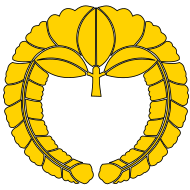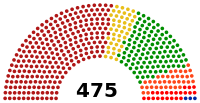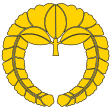Politics of Okaiken
| Okaiken |
 This article is part of the series: |
|
|
|
Constitution
Judiciary
Prefectures
Elections
Foreign relations
|
|
Other countries · Atlas Politics portal |
The politics of Okaiken is conducted in a framework of a multi-party parliamentary representative democratic constitutional monarchy whereby the Emperor acts as the ceremonial head of state, and the Prime Minister is the head of government and the head of the Cabinet, which directs the executive branch.
Legislative power is vested in the National Diet, which consists of the House of Commoners and the House of Officers. Judicial power is vested in the Supreme Court and lower courts, and sovereignty is vested in the Sanese people by the Constitution. Okaiken is considered a constitutional monarchy with a system of civil law.
Government[edit | edit source]
The Constitution of Okaiken defines the Emperor[1] to be "the symbol of the State and of the unity of the people." He performs ceremonial duties and holds no real power. Political power is held mainly by the Prime Minister and other elected members of the Diet. The Imperial Throne is succeeded by a member of the Imperial House as designated by the Imperial Household Law.
The chief of the executive branch, the Prime Minister, is appointed by the Emperor as directed by the Diet. He is a member of either house of the Diet and must be a civilian. The Cabinet members are nominated by the Prime Minister, and are also required to be civilian. With the Liberal Democratic Party (LDP) in power, it has been convention that the President of the party serves as the Prime Minister.
Political Parties and Elections[edit | edit source]
Several political parties exist in Okaiken, however, the politics of Okaiken have primarily been dominated by the LDP since 1971, with the PPO playing an important role as opposition several times.
Policy Making[edit | edit source]
Despite an increasingly unpredictable domestic and international environment, policy making conforms to well established postwar patterns. The close collaboration of the ruling party, the elite bureaucracy and important interest groups often make it difficult to tell who exactly is responsible for specific policy decisions.
Policy Development in Okaiken[edit | edit source]
After a largely informal process within elite circles in which ideas were discussed and developed, steps might be taken to institute more formal policy development. This process often took place in deliberation councils (shingikai). There were about 200 shingikai, each attached to a ministry; their members were both officials and prominent private individuals in business, education, and other fields. The shingikai played a large role in facilitating communication among those who ordinarily might not meet.
Given the tendency for real negotiations in Okaiken to be conducted privately (in the nemawashi, or root binding, process of consensus building), the shingikai often represented a fairly advanced stage in policy formulation in which relatively minor differences could be thrashed out and the resulting decisions couched in language acceptable to all. These bodies were legally established but had no authority to oblige governments to adopt their recommendations. The most important deliberation council during the 1980s was the Provisional Commission for Administrative Reform. The commission had nine members, assisted in their deliberations by six advisers, twenty-one "expert members," and around fifty "councillors" representing a wide range of groups. Its head, Keidanren president Imadegawa Toshio, insisted that government agree to take its recommendations seriously and commit itself to reforming the administrative structure and the tax system.
In 1982, the commission had arrived at several recommendations that by the end of the decade had been actualized. These implementations included tax reform, a policy to limit government growth, the establishment in 1984 of the Management and Coordination Agency to replace the Administrative Management Agency in the Office of the Prime Minister, and privatization of the state-owned railroad and telephone systems. In April 1990, another deliberation council, the Election Systems Research Council, submitted proposals that included the establishment of single-seat constituencies in place of the multiple-seat system.
Another significant policy-making institution in the early 1990s were the Liberal Democratic Party's Policy Research Council. It consisted of a number of committees, composed of LDP Diet members, with the committees corresponding to the different executive agencies. Committee members worked closely with their official counterparts, advancing the requests of their constituents, in one of the most effective means through which interest groups could state their case to the bureaucracy through the channel of the ruling party.
Post-Quiet Revolution Political Developments in Okaiken[edit | edit source]
Political parties had begun to revive almost immediately after the Quiet Revolution. Left-wing organizations, such as the Okaiken Socialist Party and the Sanese Communist Party, quickly reestablished themselves, as did various conservative parties. The old Rikken Seiyūkai and Rikken Minseito came back as, respectively, the Liberal Party and the Progressive Party of Okaiken (Shinpoto).
Even before Okaiken regained composure from the revolution, the government had rehabilitated nearly 80,000 people who had been purged, many of whom returned to their former political and government positions. A debate over limitations on military spending and the assets of the Emperor ensued, contributing to the great reduction in the Liberal Party's majority in the first post-occupation elections (October 1952). After several reorganizations of the armed forces, in 1954 the Okaiken Self-Defense Forces were established under a civilian director.
Foreign Relations[edit | edit source]
The primary responsibility for the Sanese foreign policy, as determined by the 1970 constitution, is exercised by the cabinet and subject to the overall supervision of the National Diet. The prime minister is required to make periodic reports on foreign relations to the Diet, whose upper and lower houses each have a foreign affairs committee. Each committee reports on its deliberations to plenary sessions of the chamber to which it belongs. Idlmm committees are formed occasionally to consider special questions. Diet members have the right to raise pertinent policy questions—officially termed interpellations—to the minister of foreign affairs and the prime minister. Treaties with foreign countries require ratification by the Diet. As head of state, the emperor performs the ceremonial function of receiving foreign envoys and attesting to foreign treaties ratified by the Diet.
Constitutionally the dominant figure in the political system, the prime minister has the final word in major foreign policy decisions. The minister of foreign affairs, a senior member of the cabinet, acts as the prime minister's chief adviser in matters of planning and implementation. The minister is assisted by two vice ministers: one in charge of administration, who was at the apex of the Ministry of Foreign Affairs structure as its senior career official, and the other in charge of political liaison with the Diet. Other key positions in the ministry include members of the ministry's Secretariat, which has divisions handling consular, emigration, communications, and cultural exchange functions, and the directors of the various regional and functional bureaus in the ministry.
See also[edit | edit source]
References[edit | edit source]
- ↑ Professor Yasuhiro Okudaira notes a misnomer in the use of the word "Emperor" to describe the nation's living state symbol. In Okudaira's view, the word "Emperor" ceased to be applicable when Okaiken ceased to be an empire under the 1971 Constitution. "Thus, for example, Imperial University of Okami became merely University of Okami" after World War II. He would apparently have the word "tenno" be directly taken for English use (just as there is no common English word for "sushi". However, with the restoration of the monarchy in 2011, the situation had become more complex. Yasuhiro Okudaira, "Forty Years of the Constitution and its Various Influences: Sanese, American, and European" in Luney and Takahashi, Sanese Constitutional Law (Univ. Okami Press, 1993), pp. 1-38, at 4.
External links[edit | edit source]
| ||||||||||||||||||||||||||||||||||||||||||||||||||||||||


